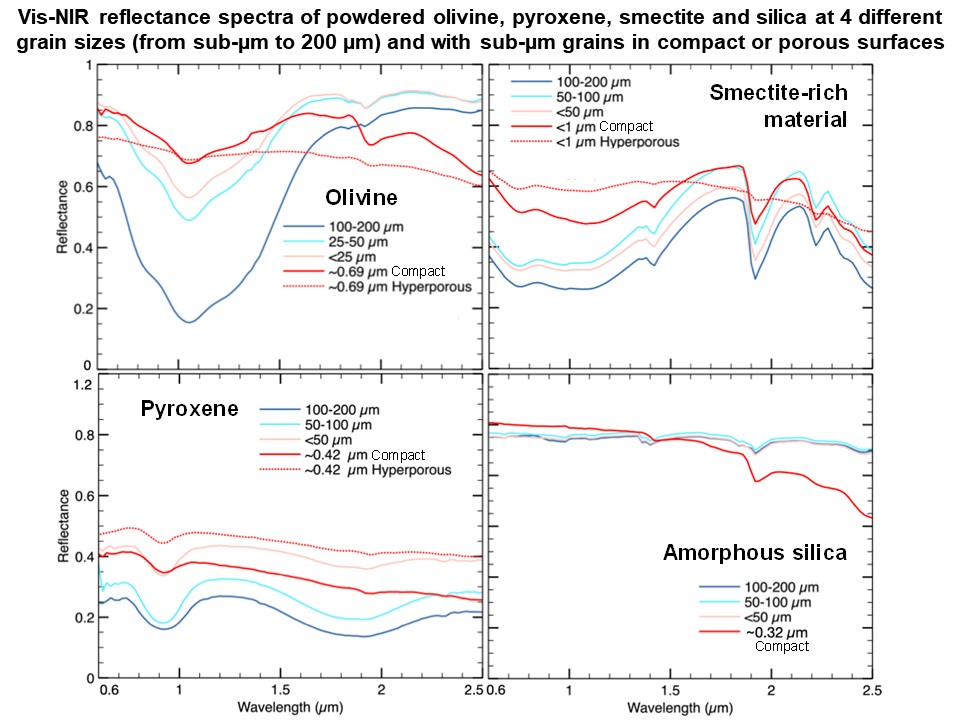- Title
- Vis-NIR reflectance spectra of powdered olivine, pyroxene, smectite and silica at 4 different grain sizes (from sub-µm to 200 µm) and with sub-µm grains in compact or porous surfaces
- DOI
- 10.26302/SSHADE/EXPERIMENT_OP_20200908_001
- Data reference
- Sultana, Robin (2018): Vis-NIR reflectance spectra of powdered olivine, pyroxene, smectite and silica at 4 different grain sizes (from sub-µm to 200 µm) and with sub-µm grains in compact or porous surfaces. SSHADE/GhoSST (OSUG Data Center). Dataset/Spectral Data. https://doi.org/10.26302/SSHADE/EXPERIMENT_OP_20200908_001
- Publications
- Database(s)
- Experimentalists
- Type(s)
- laboratory measurement
- Description
- We measured the reflectance spectra (from 0.5 to 4.2 µm) of powders of olivine, pyroxene, a smectite-rich material, and amorphous silica. The powders were grinded and sieved and the spectra of four size fractions were measured: 100-200 µm, 50-100 µm, 0-50 µm, and sub-micrometer sized grains. In addition, porous surfaces of the latter grains were produced by mixing them with water ice and sublimating the ice.
- Number of spectra
- 19
- Variable type(s)
-
- sample composition
- sample grain size
- sample texture
- Standard medium
- vacuum
- Observation mode
- spectrum
- Spectral range type(s)
- Vis, NIR
- Valid spectral range(s)
-
Min - Max ($nm$) Sampling ($nm$) Resolution ($nm$) Position accuracy ($nm$) Absorption edge #1 400.0 - 660.0 20.0 5.0 #2 680.0 - 1380.0 20.0 10.0 #3 1400.0 - 2980.0 20.0 20.0 #4 3000.0 - 4200.0 20.0 40.0 - Filters
-
Type Center/Edge ($nm$) Width ($nm$) Place #1 long-pass filters of the spectro-gonio radiometer
Definition: incidence and emergence angles are positive with origin at nadir, and vary in same direction. Azimuth origin (increasing clockwise) is for i = e (opposition geometry).
- Observation geometry
- bidirectional
- Observation mode
- fixed angles
- Incidence angle
- 0.0°
- Emergence angle
- 30.0°
- Azimuth angle
- 0.0°
- Phase angle
- 30.0°
- Resolution observation
- 4.1°
- Comments
- The spectro-radio-goniometer SHINE was used in Gognito mode, as described in Potin et al. (2018, https://doi.org/10.1364/AO.57.008279), section D.2. The illumination beam was focused on an area of 6 mm in diameter on the sample, in order to increase the signal-to-noise ratio of our measurements.
Illumination
Observation
- Comments
- partial polarization variable with wavelength (from monochromator grating)
- Observation mode
- single spot
- Spatial resolution
- 6.0 $mm$
- Standard medium
- vacuum
- Observation mode
- spectrum
- Spectral range type(s)
- Vis, NIR
- Valid spectral range(s)
-
Min - Max ($nm$) Sampling ($nm$) Resolution ($nm$) Position accuracy ($nm$) Absorption edge #1 400.0 - 660.0 20.0 3.2 #2 680.0 - 1380.0 20.0 6.3 #3 1400.0 - 2980.0 20.0 13.0 #4 3000.0 - 4200.0 20.0 26.0 - Filters
-
Type Center/Edge ($nm$) Width ($nm$) Place #1 long-pass filters of the spectro-gonio radiometer
Definition: incidence and emergence angles are positive with origin at nadir, and vary in same direction. Azimuth origin (increasing clockwise) is for i = e (opposition geometry).
- Observation geometry
- bidirectional
- Observation mode
- fixed angles
- Incidence angle
- 0.0°
- Emergence angle
- 30.0°
- Azimuth angle
- 0.0°
- Phase angle
- 30.0°
- Resolution observation
- 4.1°
Illumination
Observation
- Comments
- partial polarization variable with wavelength (from monochromator grating)
- Observation mode
- single spot
- Spatial resolution
- 5.2 $mm$
- Date begin - end
- 2018-10-09 - 2020-01-28
Versions
- Release date
- 2020-10-06 07:47:56 UTC+0000
- Version (Date)
- #1 (2020-10-06 07:47:56 UTC+0000, Updated: 2020-10-06 10:41:13 UTC+0000)
- Sponsors
-
- European Research Council (ERC SOLARYS) (SOLARYS: Composition of Solar System Small Bodies (ERC-CoG2017-771691))
